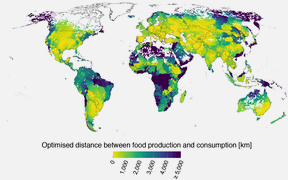Food export restrictions by a few countries could skyrocket global food crop prices
Recent events such as the Covid-19 pandemic, locust infestations, drought and labour shortages have disrupted food supply chains, endangering food security in the process. A recent study published in Nature Food shows that trade restrictions and stockpiling of supplies by a few key countries could create global food price spikes and severe local food shortages during times of threat.
‘We quantified the potential effects of these co-occurring global and local shocks globally with their impacts on food security,’ explains Aalto University Associate Professor Matti Kummu. The results of this research have critical implications on how we should prepare for future events like Covid-19, he says.
The researchers modelled future scenarios to investigate the impact of export restrictions and local production shocks of rice, wheat, and maize would have on their supply and price. These three crops form the backbone of global trade in staple crops and are essential for food security across the globe.
The results show that restriction by only three key exporters of each crop would increase the price of wheat by 70%, while maize and rice would rise by 40% and 60%. When combining this with potential local shocks that occurred last year, the prices would nearly double.
Kummu explains: ‘This is the result of an increasingly interconnected world, in which the majority of countries are dependent on imported food and, so, vulnerable to this kind of shock.’
Export restrictions risk de-stabilising global food system
‘We saw that trade restrictions by only a few key actors can create large short-term price spikes in the world market export price of grains, which can lead to food insecurity in import-dependent countries,’ explains Postdoctoral Researcher Theresa Falkendal, Potsdam Institute for Climate Impact Research.
By suddenly losing more than one-third of their annual grain supply, many low-income and lower-middle-income countries in Africa and Asia would not be able to cover this grain supply deficit with their domestic reserves, and would need alternative grain sources to survive.
‘It's important to realise that food security depends on both local and remote conditions, and imprudent policy decisions in the rich part of the world can plunge people into real hardship in poorer parts of the world,’ states Falkendal.
But shock scenarios such as those modelled by the researchers and the risks they bring may become commonplace thanks in part to global warming.
Looking to the future
The Covid-19 pandemic’s effect on global agricultural supply chains, as well as locusts destroying crops and livelihoods in the Horn of Africa and South Asia, have had a devastating effect on food security.
‘To help prevent such devastation in the future, we need proactive strategies, like reducing food waste, changing the diet towards more plant-based protein sources, and increasing the yields sustainably particularly in the most vulnerable countries,’ says Kummu.
‘While sustainable design of agricultural systems is important, it must go hand-in-hand with efforts to improve political decisions and accountability,’ says Michael J. Puma, research scientist and fellow at Center for Climate Systems Research, Earth Institute, Columbia University.
These solutions would ease a lot of pressure on resources that are needed for food production and help improve the self-sufficiency of low-income and middle-income countries.
Thus, timely and coordinated international responses are needed to minimise threats to food security especially to low-income and middle-income countries which lack the resources and purchasing power of larger nations, to ensure affordable staple grains for the world’s poorest citizens, and to avert a humanitarian crisis.
‘It’s essential that humanitarian institutions strengthen their efforts to support democratic accountability around the world, which will ultimately help us to avoid severe food insecurity and famine,’ concludes Puma.
Read the paper published in Nature Food.
More information:
Associate Professor Matti Kummu
Aalto University
+358 50 4075 171
matti.kummu@aalto.fi
Dr Theresa Falkendal
Potsdam Institute for Climate Impact Research (PIK)
+49 331 288 2482
theresa.falkendal@pik-potsdam.de
Director and Research Scientist Michael Puma
Center for Climate Systems Research, Columbia University
+1 212 678 5667
mjp38@columbia.edu
Text: Saana Kallioinen

Relying on “local food” is a distant dream for most of the world
A recent study from Aalto University shows that less than one-third of the world's population could currently meet their demand for food produced in their local vicinity

Read more news

Study: Internal combustion engine can achieve zero-emission combustion and double efficiency
A new combustion concept that utilizes argon could completely eliminate nitrogen oxide emissions from internal combustion engines and double their efficiency compared to diesel engines.
A new way to measure contagion: the gut bacterium behind blood poisoning can spread like influenza
Neither the antibiotic-resistant nor the highly virulent strains are the most transmissible.






